Web Site Layout Fundamentals: Tips For Building A User-Friendly Site
Web Site Layout Fundamentals: Tips For Building A User-Friendly Site
Blog Article
Article Produced By-Crews Skinner
When it pertains to site layout, ensuring user-friendliness is essential. From receptive design to structured navigating, every aspect plays a critical function in creating a site that caters to your audience's needs. However what about the finer information that can make or damage a customer's browsing experience? Keep tuned as we uncover some often-overlooked tips that can elevate your site's functionality to the following degree, making it really stick out in the electronic landscape.
Relevance of Responsive Design
Receptive style is an important aspect of modern website growth. Guaranteeing your website is responsive ways that it can adapt to various screen dimensions and gadgets, giving a seamless experience for individuals.
With the boosting use of smart devices and tablets to access the net, having a receptive layout is vital for getting to a larger audience. It assists in improving individual experience by making your web site simple to navigate and read on any kind of device.
Furthermore, responsive style can favorably affect your online search engine rankings, as online search engine like Google focus on mobile-friendly sites. By having a responsive design, you're additionally future-proofing your internet site, as new tools with varying display dimensions continue to emerge.
Simplify Navigation Framework
To enhance user experience and help with easy access to info on your site, streamlining the navigating framework is extremely important. When developing your website, focus on producing a clear and instinctive navigation food selection that assists site visitors locate what they're seeking promptly.
Limit https://writeablog.net/barton3blanche/ending-up-being-skillful-in-web-design-advice-and-techniques-for-developing of food selection items to the fundamentals, grouping relevant pages together to prevent frustrating customers. Usage descriptive labels that clearly show the web content of each page, making it less complicated for customers to understand where each link will certainly take them.
Take into consideration applying dropdown menus for subcategories to stop littering the primary navigation bar. Additionally, consist of a search bar plainly on the page for users who choose searching for details details.
Prioritize mobile responsiveness in your navigating layout to guarantee easy access on all devices.
Optimize Web Page Lots Speed
Improving page lots speed is critical for keeping visitors on your website. Slow-loading web pages annoy customers and can bring about high bounce prices. To maximize page lots rate, start by enhancing photos. Compress pictures without jeopardizing quality to reduce their documents sizes.
In addition, allow internet browser caching to store frequently accessed sources locally, quickening tons times for returning visitors. Minify CSS, JavaScript, and HTML documents by removing unneeded personalities, comments, and format, improving lots speed.
Think about using a content distribution network (CDN) to disperse your internet site's content throughout numerous web servers worldwide, reducing latency for customers accessing your website from different places. Finally, restrict the use of third-party manuscripts and plugins, as they can significantly impact load times.
Verdict
To conclude, by incorporating responsive layout, streamlining navigating, and enhancing web page lots rate, you can create an easy to use internet site that appeals to a broader audience and boosts individual experience. more information that visitors can easily gain access to and browse your website throughout different devices, leading to enhanced interaction and fulfillment. By focusing on these essential aspects, you can develop an effective website that maintains users returning for more.
